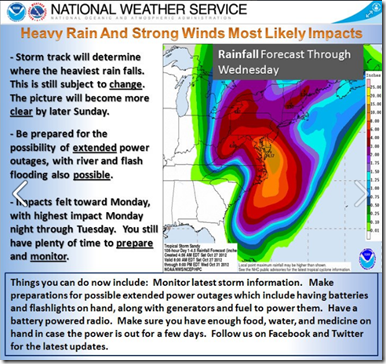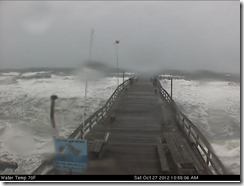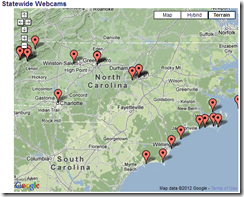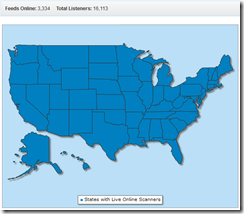Credit NWS Binghamton,NY
# 6671
Hurricane Sandy is being billed as having the potential to become a major New England storm when it merges with a mid-latitude trough coming in from the west early next week. It is even being compared with the `perfect storm’ of 1991, and so local, state and Federal emergency planners are burning the midnight oil this weekend in preparation.
There is always the possibility that Sandy will prove less damaging than feared, but one can’t simply assume that the Mid-Atlantic and New England states will get lucky.
The internet provides a unique platform for watching Sandy’s trek across Northeastern states, with resources that include live coastal radars, NOAA weather radio broadcasts, streaming radio and TV coverage from cities all across the region, beach front and traffic webcams and even scanners to listen to local emergency radio traffic.
For those in the path of the storm, or those with friends or family in the affected area, this can help provide valuable information as to what is going on during and after the storm.
And for those who are simply curious as to the impact of this hurricane, this is a convenient way to monitor it.
Disclaimer: These links are offered without warranty or endorsement (except for the NHC & NOAA links), and you visit them at your own risk.
It is always prudent to use up-to-date antivirus software, and decline to install any software from vendors you do not trust, when surfing the net.
Official sources are always your best option, so when it comes to getting the latest information on hurricanes, your first stop should be the National Hurricane Center in Miami, Florida.
These are the real experts, and the only ones you should rely on to track and forecast the storm.
To get their latest forecasts – particularly if the power is out in your area – you really need a battery operated Weather radio. Once thought of as mainly a source of local weather information, it has now become an `All-Hazards' alert system as well.
You’ll find that NOAA Weather Radio All Hazards broadcasts are available online via live streaming audio hosted by other entities, like Weather Underground. This allows you to listen to broadcasts outside of the range of your receiver.
The second official information source you should have bookmarked is your local Office of Emergency Management. There you will find information about evacuation zones, shelters, and emergency decrees in your area.
If you are on Twitter, you should also follow @FEMA, @CraigatFEMA, @NHC_Atlantic, @NHC_Pacific and @ReadydotGov.
You can access live feeds from the nation’s array of NEXRAD and TDWR radar installations, via this link at Weather Underground.
Live beach cams line the coast, and as this screen capture this morning from Kill Devil Hills, NC shows, the weather there is already deteriorating.
Raleigh broadcaster WRAL.Com has an interactive map with a number of these cams available.
The most extensive list of Northeastern Webcams I’ve found so far is HERE, although one should expect that some of these will be out of commission as the storm approaches, or slow to load due to heavy internet traffic.
Live streaming radio on the internet has grown remarkably over the past few years, and this site has links to thousands of stations. Choose Radio Stations by State to narrow down your search.
Local, county and state emergency services frequencies (fire, police, EMS) can be assessed via RadioReference.com. Their interactive maps allows you to first pick a state, and then drill down to the county you are looking for, where you’ll be presented with a list of feeds.
With more than 3,300 feeds there’s a pretty good chance you can monitor nearly every place in the country.
Hurricane City, a well known hurricane tracking site and forum, broadcasts on USTREAM when hurricanes approach the coast and you can watch it HERE.
You’ll also find live hurricane coverage and chaser cam footage from Mark Sudduth’s HurricaneTrack.com.
USTREAM, mentioned earlier, provides a venue for all types of broadcasting. Enter HURRICANE or SANDY or FRANKENSTORM in the search box for a list of current streaming video. You’ll find everything from storm chaser video to live feeds from hotels on the Altantic beaches.
Since anyone can broadcast on USTREAM, accept anything you see or hear cautiously. Still, USTREAM can be a terrific resource.
I’ll try to have more resources later, and will update this blog post if I find anything tonight. But this should give you a pretty good start on following the storm.






